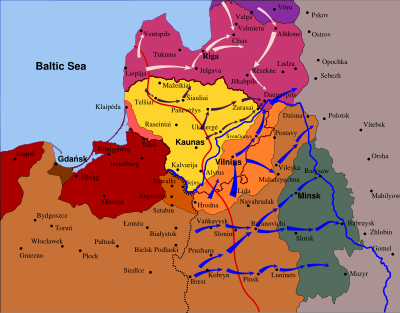
Operation Minsk
Encyclopedia

Minsk
- Ecological situation :The ecological situation is monitored by Republican Center of Radioactive and Environmental Control .During 2003–2008 the overall weight of contaminants increased from 186,000 to 247,400 tons. The change of gas as industrial fuel to mazut for financial reasons has worsened...
from the Bolshevik
Bolshevik
The Bolsheviks, originally also Bolshevists , derived from bol'shinstvo, "majority") were a faction of the Marxist Russian Social Democratic Labour Party which split apart from the Menshevik faction at the Second Party Congress in 1903....
control in early August 1919.
In the summer of 1919 after the Polish successes in several Polish-Russian skirmishes, the two combatants (both engaged on multiple fronts) have been near the limits of their capabiity to wage warfare with each other; they needed time to regroup and concentrate their forces. However the Polish High Command intended to strike one more blow against the Bolsheviks while the Polish forces were on the offensive: they decided to cripple the Western Army (Russia)
Western Army (Russia)
The Western Army or 16th Army was created on November 15, 1918, by the Russian SFSR for the purpose of recovering territories lost by the Russian Empire during the First World War and establishing Soviet republics in those territories...
(Soviet Western Division), headquartered in Minsk, and further damage Soviet logistics by taking control of this important railway center.
In July, Polish forces (the 'Northern Group') under general Stanisław Szeptycki (whose officers included Władysław Anders, Jozef Lasocki and Stefan Mokrzecki
Stefan Mokrzecki
Stefan Mokrzecki of Ostoja coat of arms was a general in the Russian Army and the Polish Army. During Polish-Soviet War commanded 8 DP and other units. Later member of armed forces of Republic of Central Lithuania. Retired in 1925...
) were strengthened to 12,000 infantry, 2,000 cavalry and 40 guns. Polish plan involved a wide pincer movement around the city of Minsk. The battle raged throughout the first week of August. Soviet forces took heavy casualties and Minsk fell to the Poles on August 8.
The success of the Polish offensive allowed the Poles to move forward again, and by the end of August Józef Piłsudski ordered his armies to stop, as he considered all territories important to Poland - and feasible to take before winter - secured.

